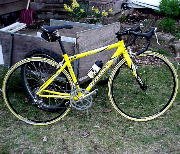 Paeonia tomentosa again. I got the focus pretty good this time, so one can blow up the central tuft, anthers and carpels, to almost full screen (2x) if you are keen on looking into the "private parts" of the flower. Somewhat risque, but the plant doesn't mind.
Paeonia tomentosa again. I got the focus pretty good this time, so one can blow up the central tuft, anthers and carpels, to almost full screen (2x) if you are keen on looking into the "private parts" of the flower. Somewhat risque, but the plant doesn't mind.The anthers (the yellow pollen sacks) sit on the ends of purpley-red filaments (stalks), and the carpels (ovaries) are the fat fuzzy bottle-like shapes in the middle (3 in this flower, but others may have more or less). At the tip of each carpel is the flat, vaguely shovel-blade-like red stigma, which is what the pollen has to stick to in order to commence fertilization. The pollen gets there mainly by insects which visit the anthers, picking up the sticky pollen deliberately or by accident and then brushing some of it off against a stigma when departing the flower; or when entering a flower with pollen from another flower. Bees in particular like rolling around in peony pollen on warm days with the intent of carting off as much pollen as their back legs can carry, to their hive, where the stuff becomes food.

No comments:
Post a Comment